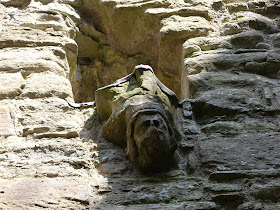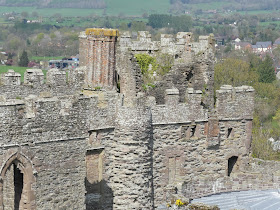Tuesday, 18th April, was cold but sunny and dry. B wanted to spend the day gardening so D and I decided to visit Ludlow and the castle. We've been to the castle before in 2014 when we went to the Medieval Christmas Fayre for my birthday treat but the castle was crowded so not easy to have a good look round then.
Ludlow was much quieter than B, E and I's last visit a couple of years ago perhaps because there was no market on although that did mean I didn't have chance to browse the Heron Cross pottery stall! I parked easily in the Castle Street car park which is very close to the castle and B had paid for a space in advance on his phone :)
Ludlow Castle

- Construction of the castle as a border stronghold started in the late C11th by Marcher Lord, Roger De Lacy.
- When the last de Lacy died in 1240 without a male heir the castle was divided between his daughters and eventually it came under the ownership of the de Geneville's
- Roger Mortimer who had married one of Roger de Geneville's daughters turned the castle into a sumptuous palace early in the C14th (more on the Mortimer connections later).
- Later the castle came under the ownership of Richard, Duke of York, and was involved in the War of the Roses.
- As a Royal Palace Edward IV sent the Prince of Wales and his brother (later they became known as "The Princes in the Tower") to live at Ludlow Castle. The castle was by this time also the seat of the Government for Wales and the Border Counties.
- In 1501 Prince Arthur (elder brother of Henry VIII) spent his honeymoon here with Catherine of Aragon his bride, before his early death.
- Queen Mary Tudor spent 3 winters at Ludlow Castle with her court between 1525 and 1528.
- In 1689 the Royal Welsh Fusiliers were founded at the castle by Lord Herbert of Chirbury but the castle was then abandoned and soon fell into decay.
- In 1811 the ruins were purchased by the 2nd Earl of Powis from the Crown and his family still own the Castle today.
The buildings seen today illustrate architecture from Norman, Medieval and Tudor times.
From the entrance to the castle you enter the large Outer Bailey which was enclosed in the 2nd half of the C13th probably by Hugh de Lacy (d 1186). The outer defences were made up of a curtain wall with gatehouse, two towers and outer ditch now mainly filled in. Inside this bailey would have been stables, storehouses and workshops. It may also have been used for troop exercises and jousting.
Here we see the Great Tower/Gatehouse leading to the Inner Bailey.
Under this grid is an entrance to an icehouse which was probably first used to store arms.
Chapel of St Peter built by Roger Mortimer (d1370) to commemorate his escape from the Tower of London on 1st August, 1323.
One feature I did forget to look for was Mortimer's Tower :( Still not to worry as we enjoyed the castle that much I am sure we will return as there were features (as always) that we missed including an exhibition and I'd love to walk round the outside of the castle.
It was lovely to see a rookery nearby.
Inner Bailey
The entrance with the Great Tower and Gatehouse to the left and the Judges' Lodgings to the right.
The Inner Bailey is encircled by a ditch.
Entrance to the Great Tower/Keep.
The Chapel of St Mary Magdalene is Norman built in the C12th and it is one of the few circular naves in Britain. It originally had a square chancel with polygonal apse the foundations of which can still be seen.
Inside there is a stone bench round the nave. Zigzag carving, scalloped capitals, round arches and blind arcades are all typical of the C12th. The nave has probably always had a stone slabbed floor but the chancel would probably have had decorated tiles.
Mortimer Connections
Ludlow Castle is only 7 miles from Wigmore Castle for many centuries the seat of the Mortimer family. Ludlow was also an important lordship and there would no doubt have been disputes beween the Mortimers of Wigmore and the Lords of Ludlow especially during the Anarchy of the C12th.
Around 1240 the last male de Lacy died and the estates were subsquently divided between two daughters and the castle and some of the town were held by the de Genevilles.
Roger IV Mortimer (d1330) married Joan de Geneville in 1301 and in 1308 Ludlow came into the possession of the Mortimers. Roger had much building work done at the Castle for example the new Great Chamber Block, the Garderobe Tower and St Peter's Chapel.
Following Roger's downfall and execution in 1330 his widow Joan held Ludlow as her own inheritance until her death in 1356.
Ludlow became the main seat of the Mortimers when they were in the area.
Edward IV Mortimer died without leaving heirs in 1425 and the Mortimer estates were inherited by his sister's son Richard, Duke of York and Ludlow became his favourite residence. Two of his sons grew up at Ludlow including one who became King of England.
After Richard's death, his eldest son Edward became the leader of the Yorkist cause and in 1461 won the Battle of Mortimers Cross. He rode to London where he was proclaimed king. After his coronation Edward IV spent time in Ludlow giving the town a new Charter and paying for further building work at St Laurence.
The North Range with the Great Hall on the left and the Great Chamber on the right. The Garderobe tower peeks above the part of the building above the scaffolding.
To the right the Great Hall and to the left the Solar Wing with Prince Arthur's apartments on the first floor.
Tudor Lodgings
The North Range and Mortimer's Palace contain some of the finest medieval domestic buildings in England. Work commenced in the 1280's by Peter de Geneville and was finished in the early C14th by Roger Mortimer to demonstrate his importance.
The North Range was built against the original Norman curtain wall and allowed access to the battlements.
The Great Hall was an important room approached by a flight of steps. The Hall would have been on the first floor with a fireplace and three windows. On the ground floor would have been a store.
The Solar Wing was initially the private apartments of the Lord and Lady of the castle. But after Roger Mortimer created the Great Chamber wing it was converted to a service area with a buttery, pantry and storeroom.
The Garderobe Tower was built again by Roger Mortimer to create extra accommodation for when he entertained. It contained several bedrooms each with its own garderobe.
Interior shots of the Great Hall, Great Chamber and Solar Wing
The Tudor Lodgings next to the Great Chamber were once called Pendover Tower and were built in the C16th to replace older buildings. It may have been used as apartments by Prince Edward and Prince Richard (the "Princes in the Tower").
Pendover Tower is said to be haunted by Marion du Bruer. Marion's lover Sir Arnold de Lis betrayed her and when she discovered this she killed him with her own sword and then jumped out of the tower window and killed herself. The ghostly figure of a young girl can be seen in the ruins on moonless nights.
It must be pointed out that the Tower was built after the time of Marion and Arnold!!!
The Keep has a complex history. The single storey gatehouse was enlarged in the C12th to make a large gatehouse/keep.
Well in the kitchen area
To the left of the Gatehouse are the Judges' Lodgings - Tudor apartments built around 1581 to house judges and clerks who had to live or stay at the castle when the Courts of the Council of the Marches were being held.
The following photos taken from the Top of the Great Tower were taken by D using my camera (the camera card on the Canon he uses was playing up). The photos look fine to me but D complained they were over exposed because I had forgotten to lower the iso! No way was I going up the tower mainly because I don't like heights but also because these days my knees may get me up there but probably not down those worn uneven spirally steps!!
Finally! (sorry this is a long post) a few photos taken inside the shop where there was also a small exhibition.
We'd spent about two hours in the castle which left us an hour to have a quick look round the town which I'll write about in the next post.
Photos taken by me and my son with the Panasonic Lumix FZ330 bridge camera. (I don't particularly rate most of my photos but if anyone wishes to use one I would be grateful for an email first - thanks)
Reference:
"Ludlow Castle - A History and a Guide" by David Lloyd MBE
Ludlow Castle Leaflet
"On the Trail of the Mortimers" by Philip Hume Logaston Press 2016
























































































































